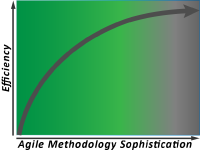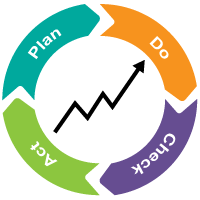Adopting Agile Marketing | Take an Easier Path
 Adopting agile marketing doesn’t need to be a traumatic, seismic shift for your marketing group. Don’t worry about deep diving into complex methodologies, or duplicating the practices of agile development. Agile marketing is foremost a mentality and a culture based on flexibility, speed, true customer value, and openness. The methodology you choose is secondary. So, start you agile marketing journey in small, simple steps. First, adopt the core disciplines of agile marketing. Then, apply some basic agile processes, see how they work, adapt them, and iterate.
Adopting agile marketing doesn’t need to be a traumatic, seismic shift for your marketing group. Don’t worry about deep diving into complex methodologies, or duplicating the practices of agile development. Agile marketing is foremost a mentality and a culture based on flexibility, speed, true customer value, and openness. The methodology you choose is secondary. So, start you agile marketing journey in small, simple steps. First, adopt the core disciplines of agile marketing. Then, apply some basic agile processes, see how they work, adapt them, and iterate.
In other words, the best approach to adopting agile marketing is an agile approach!
“The best agile methodology is the one that fits your team, not a preconceived recipe you have to follow.”
Focus First on Agile Marketing Disciplines
The biggest benefit from adopting agile marketing comes from applying core agile disciplines. These disciplines are the foundation for improved efficiency, output and alignment, no matter what agile process you implement.
The core agile marketing disciplines are:
- Measure value through the eyes of the customer. Whether you like a program is irrelevant — you are not the customer. Measure success only through real results and real feedback from real customers.
- Minimize waste by managing uncertainty. Work on the things you can do today that will produce real customer value. Be open, clear and realistic about what you are doing when.
- Maximize flexibility by working incrementally. Break big projects into smaller, manageable sub projects, so you can measure and adjust early, and recognize and remove barriers as soon as possible.
- Foster alignment and collaboration through transparency. Broadly sharing information about plans, projects and results creates understanding and alignment, and encourages input.
- Improve incrementally and continuously. Plan, do, check, act — in small increments. Don’t be afraid to fail, just don’t fail the same way multiple times. Learn as quickly as possible, improve, and iterate.
(To learn more about agile marketing disciplines, check out the ebook agile marketing disciplines)
It’s important to make these disciplines a part of your marketing culture. Discuss and debate them with your team. If your team understands the basics of these disciplines and applies them, you can be successful with a wide range of agile processes.
Building those processes is your next step.
Start with Basic Agile Marketing Processes
 The key to successfully adopting agile marketing is to get just enough process in place to support your agile disciplines. Then, adjust the process to best fit your team. No agile methodology is right, or wrong. You may have heard of Scrum, Kanban, Lean and other agile methodologies, which have been borrowed from agile manufacturing and development, and applied to agile marketing. They may be ideal for your team, but they may also be too complex and intimidating as a whole. A simpler, easier path to adopting agile marketing is to start with some basics processes that you can quickly adopt, then evolve into a methodology that works well for you. The best agile methodology is the one that fits your team, not a preconceived recipe you have to follow.
The key to successfully adopting agile marketing is to get just enough process in place to support your agile disciplines. Then, adjust the process to best fit your team. No agile methodology is right, or wrong. You may have heard of Scrum, Kanban, Lean and other agile methodologies, which have been borrowed from agile manufacturing and development, and applied to agile marketing. They may be ideal for your team, but they may also be too complex and intimidating as a whole. A simpler, easier path to adopting agile marketing is to start with some basics processes that you can quickly adopt, then evolve into a methodology that works well for you. The best agile methodology is the one that fits your team, not a preconceived recipe you have to follow.
To get started, here are some basic agile processes to consider. Try these, then adapt and expand them to fit your team.
✓ Agile Basic 1 | Create and Publicize a Backlog
Create a prioritized backlog that specifies what you will, and will not be working on (a great basic from Scrum).
First, make sure everyone understands each item. Any item that is unclear should sit at the bottom of your backlog until it is clear. Then, (mimicking a key part of Lean), rate and prioritize each idea along two dimensions: 1) the customer value it will create and 2) the amount of work involved.
Now, make sure everyone can see your prioritized backlog. No magic here. Share the list on your intranet, tape it to a wall, or use an app that shares your work with everyone – whatever works for you. Make sure everyone can see the list, because alignment and collaboration start with visibility of what your marketing team are, and are not, doing.
✓ Agile Basic 2 | Establish Defined Periods of Work
Bound and limit periods of work to create focus and increase productivity.
Create a defined period of time (called a “sprint” in Scrum), and choose projects from your prioritized back log to complete during that timeframe. Make the timeframe reasonably short, say two weeks, and don’t stretch it to fit more projects — you can get to them in the next sprint. It’s important to define a limited sprint, because it gives your team a clear end point by which to complete a specific set of projects. This allows your team to focus on those, and only those, projects assigned to that sprint.
Switching costs are a major cause of wasted cycles. So, be diligent about not adding new projects mid sprint. This may cause heartburn with colleagues who are used to asking for emergency projects. But in the long run, making your team more efficient will benefit everyone, so stick to your sprint plan.
✓ Agile Basic 3 | Break Big Projects into Small Projects
Divide all projects longer than one week into sub projects no more than one week (shorter wherever you can), and turn all unbounded work into bounded steps whenever possible.
Estimating work for big projects is rarely accurate, and commonly leads to missed dates, wasted cycles and stressed team members. When you break big projects into small projects, the work becomes more manageable, and predictable. Progress is more easily measured and monitored with small projects. If problems arise with a small project, you can take palliative steps when it’s only days late, instead of trying to fix a big project that is a month late. Smaller projects also create the opportunity to test earlier, and make corrections before follow-on work is done, eliminating wasteful rework (a basic adapted from Lean methodology).
Similarly, unbounded work is hard to manage. Many projects in marketing rely on creativity, where it is difficult to dictate bounded time frames. So, don’t try. Instead, find ways to define bounded steps in the process, like delivering first and second drafts within specific time limits. The total effort and endpoint of a big creative project may be unknowable, but you can start with and manage smaller checkpoints.
Work everything in manageable increments. Check and test as early as possible — and create opportunities for early improvement.
✓ Agile Basic 4 | Test Early with Real Customers
Focus on driving results with real customers above solely meeting project specifications.
This may seem academic, but is not practiced enough. If a marketing project meets all the requirements specified by its owner, can it be labeled a success? No. It can only be labeled a success if it drives the impact for which it was intended. For instance, is it more important to deliver email content that the team likes, or that drives prospect conversions?
Team input is valuable, but prospect or customer input is critical. Test outlines with your target audience before writing the full copy. Use A / B testing when developing new themes. Monitor sentiment on social media. Although it’s often difficult, the key point is to test with customers or prospects whenever and as early as possible to measure real reactions. Then, adjust according to the data and feedback. Everyone involved will be much happier with customer success than with perfect adherence to specifications.
✓ Agile Basic 5 | Run Regular Heartbeat Meetings
Create a regular cadence of communication and involvement.
“Stand-up meetings” (as they are called in Scrum and Kanban) are a great example. These are short meetings where the participants literally stand while briefly discussing what they have accomplished, what they are doing next, and any barriers they face. The meetings should be regular, held either daily or two to three times per week, and should be short and focused. Each team member contributes their brief update, and only their update. Topics requiring additional discussion should be saved for other meetings with only the necessary participants, not the whole team.
Regular stand ups expose barriers early, and reinforce the drive to complete projects. Who wants to repeatedly report to their colleagues that they have no progress to report, right?
✓ Agile Basic 6 | Share Everything
Make broadly sharing information a core part of your process.
Sharing information with others is foundational to agile success. Beyond sharing your backlog as discussed above, you should also share sprint progress (called a burn-down), sprint barriers, project performance metrics and team member assignments. Publishing information keeps others up to date, and also produces other big benefits.
Sharing aids alignment. When you share and encourage commentary on plans and problems, others become invested in, and aligned with, your efforts. Sharing also stimulates collaboration. Visibility of plans, problems and ideas in a workgroup is clearly critical to collaboration. But, sharing the same information beyond the workgroup can produce solutions and options that might be missed.
Whether you update an intranet or a whiteboard, or use a tool designed to automatically share your work, make sharing information a mandatory part of your process. And, when in doubt, opt to share more rather than less.
Adopting Agile Marketing on Your Own Path, Step by Step
 The basic agile processes and the agile disciplines above will give you a great start when adopting agile marketing. You may be pleasantly shocked at the increased efficiency gained from just this simple start.
The basic agile processes and the agile disciplines above will give you a great start when adopting agile marketing. You may be pleasantly shocked at the increased efficiency gained from just this simple start.
Is this all there is to agile marketing? Unquestionably, no. There are many other suggested processes. But, there is no prescribed methodology that you must follow to benefit from adopting agile marketing. As I led with, agile marketing is foremost a mentality and a culture based on flexibility, speed, true customer value and openness. So, choose your own simple steps to ease into agile. Try what you like from the basics above, or other processes. Test them. Learn from the results and improve. That is a successful method for adopting agile marketing. After all, it’s the agile way!
Jim Burleigh
Latest posts by Jim Burleigh (see all)
- Marketing Project Management Software vs. Generic Project Management Software - December 8, 2015
- Adopting Agile Marketing | Take an Easier Path - November 16, 2015

1 Comment
[…] Adopting Agile Marketing | Take an Easier Path […]